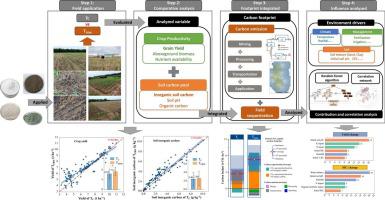Agricultural Systems ( IF 6.6 ) Pub Date : 2023-06-08 , DOI: 10.1016/j.agsy.2023.103691 Fuxing Guo , Yanping Wang , Haoyong Zhu , Chuangye Zhang , Haowei Sun , Zhuling Fang , Jing Yang , Linsen Zhang , Yan Mu , Yu Bon Man , Fuyong Wu

|
CONTEXT
Farmland enhanced rock weathering (ERW) is a negative emission technology that accelerates CO2 sequestration into the soil inorganic carbon (SIC) sink by applying calcium and magnesium-rich silicate rock to agricultural soils. Farmland ERW has great CO2 removal potential and is accompanied by various co-benefits, such as improving soil pH and providing mineral nutrients. However, the environment-driven mechanisms of ERW remain unclear, and the uncertainty on crop productivity also requires further evaluation in field trials.
OBJECTIVE
We tried to explore the response of crop productivity and soil inorganic carbon to ERW in farmland and analyze the contribution and prioritization of environment drivers for the above change.
METHODS
A series of monitoring trials were established in a multi-agroclimatic region in central China from 2019 to 2021. Firstly, crop productivity and SIC change mediated by ERW were evaluated by applying 10 kg m−2 mixed rock powder in field trials. Secondly, the random forest and correlation network analysis were used to quantify the influence of climate, soil, and management drivers on yield and SIC change. Finally, the carbon footprint of silicate rock powder was calculated by life cycle analysis.
RESULTS AND CONCLUSIONS
Farmland ERW significantly improved the crop yield (7 ± 4.3%) and biomass (11 ± 4.6%) in the whole region. In the low water balance region, the net carbon sequestration during three years caused by ERW was 4.31 ± 0.82 t-CO2 ha−1, which increased the carbon capture of the agricultural system by 1.6–2.4 times. Contribution analysis showed that soil pH had the highest relative importance (18%) on yield change mediated by ERW. Low soil pH was conducive to yield and nutrient effectiveness increases, and the largest yield increase reached 31 ± 6.9%. Water balance (rainfall/evapotranspiration) was the dominant driver affecting (20%) inorganic carbon sequestration, the accumulation of SIC in low water balance reached 3.8 times that in high water balance regions. Moreover, fertilizer input also significantly correlated with ERW field effect, and N input significantly increased the SIC in the arid region.
SIGNIFICANCE
This study provided detailed field data for large-scale potential analysis of ERW in farmland. These findings contribute to understanding the environmental influence of ERW and assisting decision-making for ERW layout. Moreover, our results could inspire soil improvement in regions with soil acidification and mineral nutrient shortages.



























 京公网安备 11010802027423号
京公网安备 11010802027423号